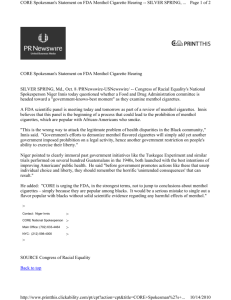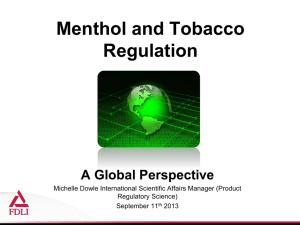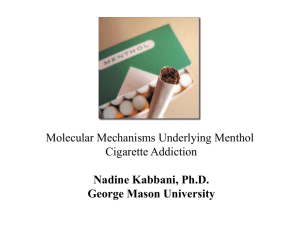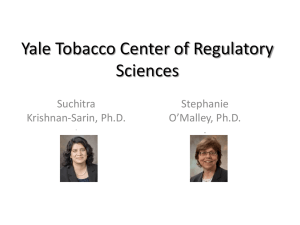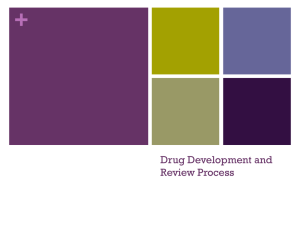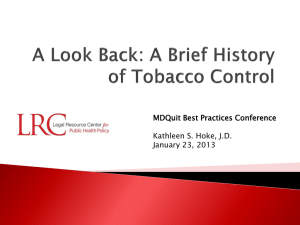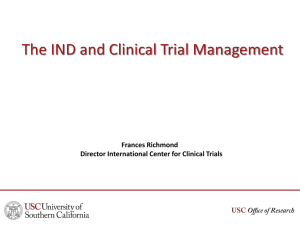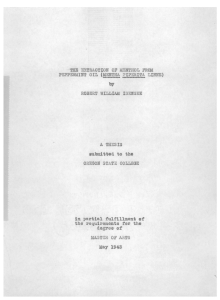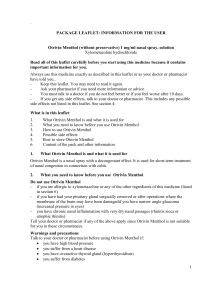Patricia Kovacevic`s Slides - Food and Drug Law Institute
advertisement
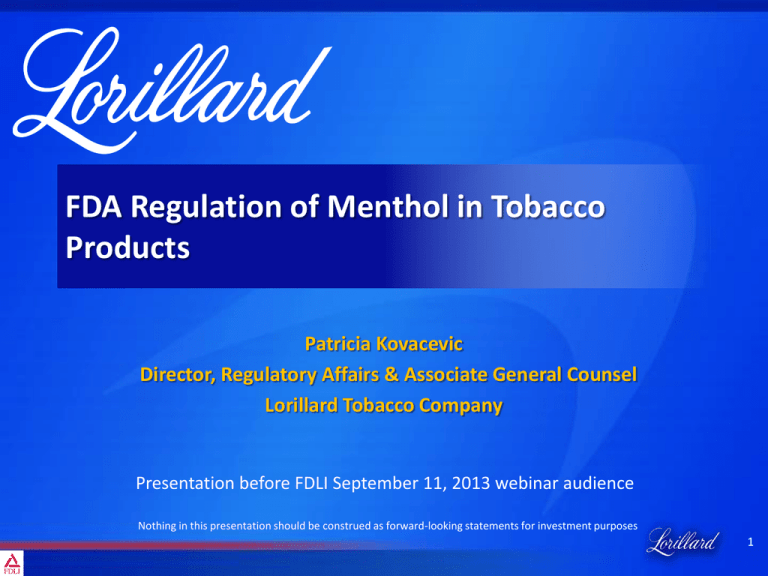
FDA Regulation of Menthol in Tobacco Products Patricia Kovacevic Director, Regulatory Affairs & Associate General Counsel Lorillard Tobacco Company Presentation before FDLI September 11, 2013 webinar audience Nothing in this presentation should be construed as forward-looking statements for investment purposes 1 Where are we now? • Smoking in the U.S. is declining – The number of cigarettes distributed to wholesalers and retailers in the U.S. is declining: • 2008 - 322.6 billion • 2009 - 290.3 billion • 2010 - 282.0 billion (1) • Menthol is safe – Recognized as a GRAS (Generally Recognized As Safe) ingredient for use in food and also as a direct food additive by the FDA – Used in numerous consumer products and drugs: chewing gum, mouthwashes, nicotine inhalers, etc. (1) FTC Cigarette Report for 2009 and 2010 2 There is No Correlation Between Menthol Share and Youth Smoking in the U.S., at the State Level % % 30 25 70 Youth prevalence smoking (LHS) Menthol share of market (RHS) 60 50 20 40 15 30 10 20 10 0 0 Hawaii DC Maryland Delaware Pennsylvania Mississippi South Carolina New York New Jersey Michigan Rhode Island Virginia Connecticut Wisconsin North Carolina Georgia Illinois Louisiana Alabama Florida Massachusetts Ohio Indiana Tennessee Arkansas Missouri Texas Nebraska Nevada Kansas Iowa Minnesota West Virginia Arizona California Kentucky Colorado Washington South Dakota New Hampshire Oklahoma New Mexico Alaska Utah North Dakota Vermont Wyoming Maine Oregon Idaho Montana 5 Source: YRBS, see footnote 2,(YRBS) and Lorillard Tobacco In 2011. Source: Youth Risk Behavior Surveillance System and Lorillard TobaccoCompany, Company shipment volume from wholesale to retail. shipment volume from wholesale to retail The 2009 YRBS was used for Missouri, Nevada and Pennsylvania. Data for Minnesota were taken from the Minnesota Youth Tobacco and Asthma Survey 2011; data for California from the County and Statewide Archive of Tobacco Statistics 2010; data for Oregon from Oregon Healthy Teens 2011; and data for Washington from Washington State Healthy Youth Survey 2010 3 And yet FDA is considering restrictions on menthol • TPSAC report published March 23, 2011 • FDA issued an Advanced Notice of Proposed Rule Making (“ANPRM”) on July 24, 2013 – seeking comments on possible product standards and sale/distribution, marketing/promotion, and other possible restrictions – seeking comments on whether restrictions should apply to other tobacco products beyond cigarettes • FDA also published its Preliminary Scientific Evaluation of the Possible Public Health Effects of Menthol v. Nonmenthol Cigarettes • 60-day comment period –due Sept. 23, 2013 4 If FDA seeks to establish a product standard . . . • Must issue Proposed Rule – Must fairly consider all of the issues required by Section 907 of the FDCA – Comment period: at least 60 days • To promulgate a Final Rule, agency must: – Consider and respond to comments submitted – Comply with all other requirements for promulgating a rule (federalism, environmental impact, economic impact statement) 5 . . . and can only issue the standard based on “scientific evidence” . . . • In order to promulgate a product standard on menthol, FDA must consider “scientific evidence” concerning: – Risks and benefits to the population as a whole (users + nonusers) – Likelihood that existing users will stop using such products; – Likelihood that new users will initiate using such products. • FDA’s Draft Guidance on MRTP applications establishes standards for the scientific evidence required to support FDA decision-making 6 . . . and if the standard is appropriate for the protection of public health • FDA may adopt a product standard if it “would be appropriate for the protection of the public health” • FDA’s draft guidances on premarket tobacco product applications (PMTAs) and MRTP applications provide guidance on the rigorous studies necessary to meet this standard 7 Currently, science does not support restricting menthol . . . “This review of the scientific evidence, which includes epidemiology studies, as well as those of biomarkers of exposure and harm, smoking topography, toxicology and chemistry, clearly demonstrates that smokers of menthol cigarettes are at no greater risk of developing smoking-related diseases than are non-menthol smokers.” No Difference • Epidemiology • Biomarkers • Toxicology • Chemistry • Smoking Topography The Industry Menthol Report, Chapter 3. 8 For example, FDA and even TPSAC Agreed that Additional Research on the Topic of Initiation is Needed Overall, there is a paucity of data on this topic... A lack of data prevents further conclusions on the role of menthol cigarettes in the initiation of smoking. - “Menthol and Initiation of Smoking” FDA draft white paper, published May 23, 2011 in Tobacco Induced Diseases In the course of reviewing the evidence related to its charge, TPSAC noted gaps in understanding of menthol cigarettes and public health that should be addressed with further research. ….. Cohort studies of adolescents and young adults should be carried out that follow participants from experimentation to initiation to dependence. These studies would provide an improved understanding of the risk for moving across this sequence that is associated with menthol cigarette availability. - TPSAC Menthol Report, March 2011 9 . . . and FDA must consider the countervailing effects of disproportionate menthol regulation • FDA must also consider “technical achievability” and “countervailing effects,” including contraband 72% of Current Menthol Sales Would Be Sold On Black Market Black Market will be significant Estimate from Compass Lexecon Report Increased youth access Counterfeit cigarettes with unknown ingredients • TPSAC devoted only 3 out of 231 pages and stated: “FDA would need to assess the potential for contraband menthol cigarettes as required by the Act” • To date, FDA has not published evaluations of the countervailing effects of removing menthol cigarettes from the market 10 FDA Must Consider Many Major Government Bodies that Have Warned about Contraband Risks Further, the illicit [tobacco] trade has been linked to organized crime and violent crime, and poses a serious risk to our national security.” - Department of Treasury Report to Congress, 2/4/2010 Law enforcement intelligence reports have indicated that gangs and other organized crime rings have increasingly begun to focus their efforts on cigarette trafficking as a source of revenue. The profit margins on black market cigarettes are now greater than for cocaine, heroin or illegal firearms.” - Report of the Virginia State Crime Commission (SJR 21, 2010) Banning all cigarettes – or any type of cigarette favored by a large portion of U.S. smokers – could significantly increase the existing black market for cigarettes and all the attendant contraband trafficking and other illegal activity. There is already a sizeable black market for cigarettes in the United States.” - United States Trade Representative report to WTO, 11/16/2010 11 Also FDA must consider and study alternatives before banning menthol • ANPRM sets forth other possible regulatory actions: – Sales and distribution restrictions – Marketing and promotion restrictions – Limiting/banning other additives that produce a menthol flavor – “Stepped approach” – Other, unspecified actions that may be proposed • But there is little scientific evidence evaluating any of these actions – The scientific record should be developed for such alternatives before any action is taken 12 In conclusion, Lorillard appreciates that FDA is pursuing additional research • FDA must conduct rigorous, prospectivelydesigned, well-controlled studies • FDA-NIH funded PATH Studies may provide additional information on menthol over the next several years “As a regulatory agency, we can go only as far as the regulatory science will take us.” “The bottom line is, we need more information.” Mitch Zeller, CTP Center Director, quoted in NYT on July 23, 2013 13
